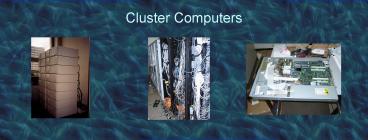Cluster Computers - PowerPoint PPT Presentation
Title:
Cluster Computers
Description:
Myrinet 1.28 Gbit/s (full duplex) Operating system: Red Hat Linux. DAS-2 Cluster (2002-now) ... full duplex Myrinet link. PCI bus interface. Software. LANai ... – PowerPoint PPT presentation
Number of Views:25
Avg rating:3.0/5.0
Title: Cluster Computers
1
Cluster Computers
2
Introduction
- Cluster computing
- Standard PCs or workstations connected by a fast
network - Good price/performance ratio
- Exploit existing (idle) machines or use (new)
dedicated machines - Cluster computers versus supercomputers
- Processing power is similar based on
microprocessors - Communication performance was the key difference
- Modern networks (Myrinet, SCI, Infiniband) may
bridge this gap
3
Overview
- Cluster computers at our department
- 128-node Pentium-Pro/Myrinet cluster
- 72-node dual-Pentium-III/Myrinet-2000 cluster
- Part of a wide-area system Distributed ASCI
Supercomputer - Network interface protocols for Myrinet
- Low-level systems software
- Partly runs on the network interface card
(firmware)
4
Distributed ASCI Supercomputer(1997-2001)
5
Node configuration
- 200 MHz Pentium Pro
- 128 MB memory
- 2.5 GB disk
- Fast Ethernet 100 Mbit/s
- Myrinet 1.28 Gbit/s (full duplex)
- Operating system Red Hat Linux
6
DAS-2 Cluster (2002-now)
- 72 nodes, each with 2 CPUs (144 CPUs in total)
- 1 GHz Pentium-III
- 1 GB memory per node
- 20 GB disk
- Fast Ethernet 100 Mbit/s
- Myrinet-2000 2 Gbit/s (crossbar)
- Operating system Red Hat Linux
- Part of wide-area DAS-2 system (5 clusters with
200 nodes in total)
Ethernet switch
Myrinet switch
7
Myrinet
- Components
- 8-port switches
- Network interface card for each node (on PCI
bus) - Electrical cables reliable links
- Myrinet switches
- 8 x 8 crossbar switch
- Each port connects to a node (network interface)
or another switch - Source-based, cut-through routing
- Less than 1 microsecond switching delay
8
24-node DAS-1 cluster
9
128-node DAS-1 cluster
- Ring topology would have
- 22 switches
- Poor diameter 11
- Poor bisection width 2
10
Topology 128-node cluster
- 4 x 8 grid withwrap-around
- Each switch is connectedto 4 other switchesand
4 PCs - 32 switches (128/4)
- Diameter 6
- Bisection width 8
11
Myrinet interface board
- Hardware
- 40 MHz custom cpu (LANai 4.1)
- 1 MByte SRAM
- 3 DMA engines (send, receive, to/from host)
- full duplex Myrinet link
- PCI bus interface
- Software
- LANai Control Program(LCP)
12
Properties of Myrinet
- Programmable processor on the network interface
- Slow (40 MHz)
- NI on the I/O bus, not the memory bus
- Synchronization between host and NI is expensive
- Messages are staged through NI memory
13
Network interface protocols for Myrinet
- Myrinet has programmable Network Interface
processor - Gives much flexibility to protocol designer
- NI protocol low-level software running on NI
and host - Used to implement higher-level programming
languages and libraries - Critical for performance
- Want few µsec latency, 10s MB/sec throughput
- Goal give supercomputer communication
performance to clusters
14
Basic Network Interface protocol for Myrinet
- Implement simple interface
- send (destination, buffer)
- poll()
- handle_packet (buffer)
- Map network interface (NI) into user space to
avoid OS overhead - No protection (or sharing)
- No flow control
- Drop messages if buffers overrun
- Unreliable communication
15
Basic NI protocol - Overview
16
Basic NI protocol - Sending packets
17
Issues
- Optimizing throughput using Programmed I/O
instead of DMA - Making communication reliable using flow control
- How to receive messages polling overhead gt
Interrupts vs. polling - Efficient multicast communication
18
Control transfers polling versus interrupts
- Interrupts
- User-level signal handlers are very expensive (24
µsec on BSD/OS) - Polling
- Hard to determine optimal polling rate
- Burdon on programmer or compiler
- Combine polling and interrupts
- Host polls when idle, else it enables interrupts
- Requires integration with thread scheduler
- Polling watchdog (LFC)
- Generate interrupt only if host does not poll
within T µsec - Implemented using timer on NI
19
Multicast
- Implement spanning tree forward protocol on NIs
- Reduces forward latency
- No interrupts on hosts
1
2
3
4
20
Performance on DAS
- 9.6 µsec 1-way null-latency
- 57.7 MB/sec point-to-point throughput
- 48.0 µsec multicast null-latency
- 11.0 MB /sec multicast throughput

